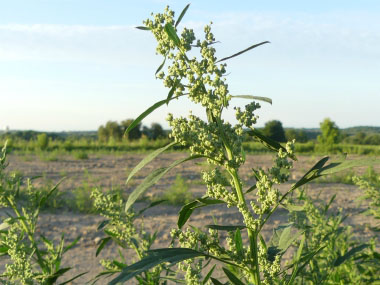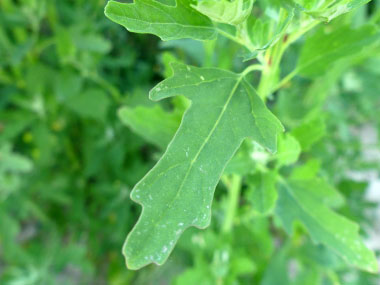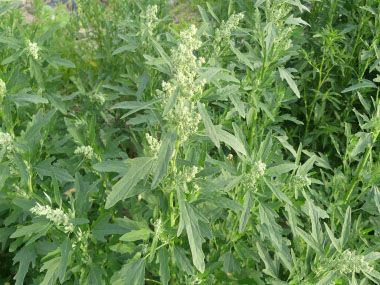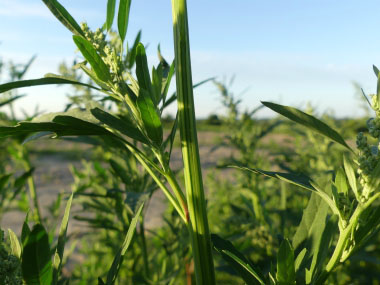






To support our efforts please browse our store (books with health benefits, etc.).
Easily recognized but often referred to as lamb's quarters, the figleaved goosefoot is a common plant in many countries around the world. This annual plant can be confused with Atriplex patula (common orache), but this is edible as well. Figleaved goosefoot is Feigenblättriger Gänsefuß (German), Fíkjunjóli (Icelandic), Fikenmelde (Norwegian), Quenopodio con hojas de chumbera (Spanish), Chénopode à feuilles de figuier (French) and Farinello a foglie di fico in Italian.
Distinguishing Features
Apart from the obvious feature of looking like a lamb's quarter, a closer examination of the leaf will show that it is different in shape. The leaves have a fig-like shape.
Flowers
It is in flower from July to September (northern hemisphere), and the seeds ripen from August to October. The species is hermaphrodite and are pollinated by wind. It has an inflorescences terminal, is richly branched, panicle-like and dense. The flower has five tepals, five stamens and two stigmas.
 Fields
of Nutrition has medicinal benefits and vitamin/mineral content of Figleaved Goosefoot.
Fields
of Nutrition has medicinal benefits and vitamin/mineral content of Figleaved Goosefoot.
Leaves
Leaves grow alternate, are fig-shaped and the margins are smooth.They are usually light green,and the petiole measures 1 to 2o cm long. The blade has three lobes that measure 4 to 8 cm long,and are up to 4.5 cm wide at the widest point. Bracts are narrowly elliptic to lanceolate. Middle leaves have 3 dentate lobes.
Height
20 to 90 cm (up to 36 inches). The stem is subangular, striped with green, and sometimes has small red spots in the leaf axils. The main stem is erect; and the branches are mainly in the upper part.
Habitat
Figleaved goosefoot likes to grow in disturbed soils and in arable land. It really likes rich soils and areas close to compost heaps. This plant grows primarily in eastern Canada, in a few of the continental states and it grows in many European, Middle East, Asian and northern African countries. It also grows in New Zealand and Australia.
Edible Parts
Leaves and flowers can be eaten raw or cooked although cooked is advised. Raw leaves should only be eaten in small quantities. Seeds can be roasted and eaten.
Other Name
Figleaf goosefoot.
Similar Plants
Common Orache.
Winter Survival Food Handbook

PDF Plant Magazines
Types of Wild Food
Geographic Zones Seasons
Disclaimer
EdibleWildFood.com is informational in nature. While we strive to be 100% accurate, it is solely up to the reader to ensure proper plant identification. Some wild plants are poisonous or can have serious adverse health effects.
We are not health professionals, medical doctors, nor are we nutritionists. It is up to the reader to verify nutritional information and health benefits with qualified professionals for all edible plants listed in this web site. Please click here for more information.
Why Edible Wild Food?
- Food costs are rising
- Free, wild food is readily abundant
- Wild food adds nutrition to your diet
- Wild food can help treat various medical conditions





